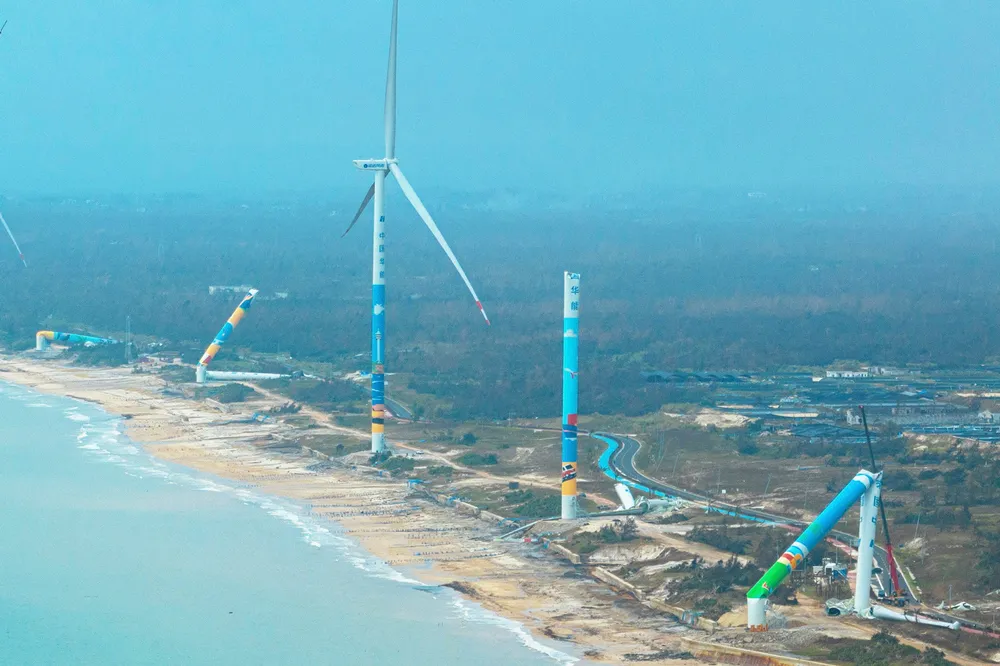Why were 'typhoon-proof' Chinese wind turbines flattened by Typhoon Yagi?
Super typhoon left turbines made by leading OEM Windey strewn across the beaches of 'China’s Hawaii'

As well as a trail of death and destruction across South East Asia, Super Typhoon Yagi left some awkward questions for leading turbine maker Windey, whose "typhoon-proof" 6.25MW machines were left bent, battered and broken at a Chinese wind farm.
After forming in warm seas around the Philippines, Yagi slammed into China on Friday with winds of 245km per hour before going on to wreak further havoc in Vietnam over the weekend, claiming dozens of lives in the process.
A super typhoon said to be the strongest to hit China in a decade, Yagi made landfall in China on the southern island province of Hainan.
Specifically, it landed in an area known as Mulan Bay, home to the Wenchang Wind Power Plant, which its owner Huaneng Hainan Company, a subsidiary of state-owned energy firm China Huaneng Group, is currently repowering.
Indeed, video footage in the wake of the typhoon shows the Windey logo on the side of some of the turbines that remained standing. At least six others were left strewn over the beaches of Hainan, known as ‘China's Hawaii.’
Claus Burchardt, who lists himself as chief engineer for blades at Goldwind on LinkedIn, commented in response to a video of the flattened turbines that Windey should “design them in a proper way,” including for typhoon conditions. “That is what the rest of us are doing!”
Windey did not respond to requests for comment, including on the exact model of turbine that was being installed. However, a product list on its website gives two turbine models with a 6.25MW rating – its WD172-6250 and WD185-6250 machines.
Windey says those models can withstand extreme wind speeds of 59.5 metres per second. Yagi, which reportedly slammed into Hainan just 7km from the turbines, is reported to have brought wind speeds comfortably above that, at around 68 metres per second.
“When aligned with the wind direction,” he said both the nacelle and the rotor blades “expose the smallest possible area to the wind and the risk of vibrations caused by the wind is at a minimum,” reducing the strain on them in extreme conditions.
Not being able to do this would have “likely to have contributed significantly to the extent of damage observed.”
Designing turbines suitable for higher wind speeds is “significantly more expensive,” said Klett, and manufacturers therefore often “strive for an economical optimum” rather than for what is “technically possible” in terms of resiliency.
“We will need to accept that sometimes serious damage and complete structural failure of wind turbines will occur,” he said, even if the “targeted probability” of this happening is very low.
The two Windey 6.25MW turbine models are designed to IEC (International Electrotechnical Commission) class S standards. This is as opposed to IEC class T turbines, a class designed to be especially resilient to typhoons.
The design limit of the turbines is in any case “meaningless” in a scenario where the turbines were not powered up and could not yaw their position out of the wind, Gareth Brown, CEO of Clir Renewables, a market intelligence platform for wind and solar farms, wrote on LinkedIn.
“Bottom line: Building a wind farm during the typhoon season and without adequate backup power was probably the primary reason behind the destruction witnessed in this storm.”
But he called for a pause in the “mad” rush by OEMs to produce ever larger turbines, which he said would allow for “robust assessment” of newer models to better understand “unknown unknowns” and establish their reliability across a range of geographies.
(Copyright)